
Kurt Sleeping, 1995 oil on board 27.9 × 35.6 cm Private Collection, New York
© Elizabeth Peyton; courtesy Sadie Coles HQ, London; Gladstone Gallery, New York and Brussels; neugerriemschneider, Berlin
Elizabeth Peyton’s exhibition at the Hara Museum of Contemporary Art marks the first major survey of her work in Japan. The artist has personally selected a group of over 40 works from across her twenty-five-year career, compiling a display which is intuitive in its interconnections and ranging in its scope. The resulting exhibition bears witness to the various genres and subjects which have come to define Peyton’s practice, and features many of the pivotal works in her career.
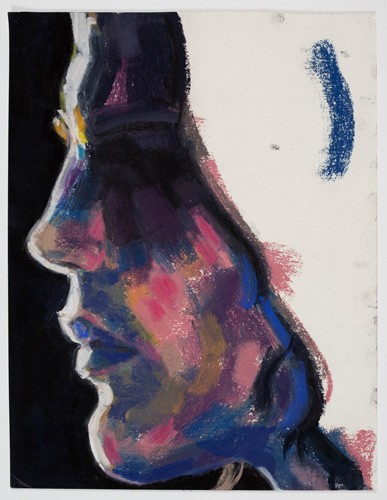
Tim (Profile), 2013 pastel on paper 29.8 × 23.5 cm Private Collection
© Elizabeth Peyton; courtesy Sadie Coles HQ, London; Gladstone Gallery, New York and Brussels; neugerriemschneider, Berlin
Peyton works primarily in painting, drawing and printmaking. She is best known for her portraits, whose subjects include figures from her own life and beyond it – close friends, historical personae, or icons of contemporary culture. Her portraits have regularly featured artists, writers, musicians and actors. In recent years she has also subsumed the genres of cityscape, still-life and opera into her range of reference and inspiration. In the process, she has embraced and expounded a more expansive and abstract definition of portraiture.
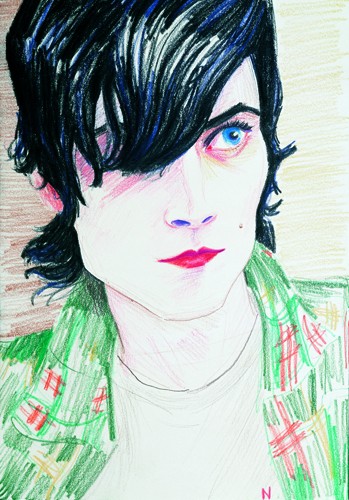
Nick (First drawing), 2002 color pencil on paper 22.2 × 15.2cm Collection David Teiger Trust
© Elizabeth Peyton; courtesy Sadie Coles HQ, London; Gladstone Gallery, New York and Brussels; neugerriemschneider, Berlin
Working variously from life and from photographs, Peyton’s portraits combine insights into historical and artistic portraiture – from Courbet to Warhol – with a freedom and range of expression that are markedly contemporary, so as to oscillate between mundane and transcendental registers. Her earliest works reimagine characters from history and literature, in particular those who have come to be defined by multiple layered narratives. In a painting and drawing from the mid-1990s, the figure of King Ludwig II of Bavaria (1845-1886) appears as a symbol of fin de siècle extravagance, but equally as a lens through which the artist examines the role and nature of portraiture itself.
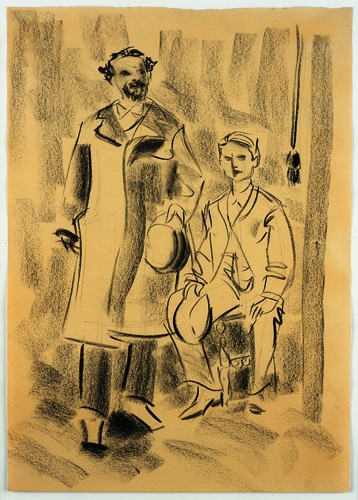
Ludwig II with Josef Kainz, 1992 charcoal on newsprint 41.9 × 29.8 cm Private Collection, New York
© Elizabeth Peyton; courtesy Sadie Coles HQ, London; Gladstone Gallery, New York and Brussels; neugerriemschneider, Berlin
Other works from this stage in Peyton’s career present contemporary figures as if from the same historical remove. Her portrayals of Kurt Cobain encapsulate both the human subject and the superhuman hagiography surrounding his life and death. In Kurt Sleeping (1995), she imagines him in an unguarded moment, while invoking the metaphorical proximity of sleep and death. Throughout her career, Peyton has also depicted figures from her own life and surroundings. Prince Eagle (Fontainebleau) (1999) shows the artist’s friend … walking beside the canal of the historic French chateau, introspective against the splendor of the setting. Present-day subjects are frequently represented in this way, through and against historical contexts.
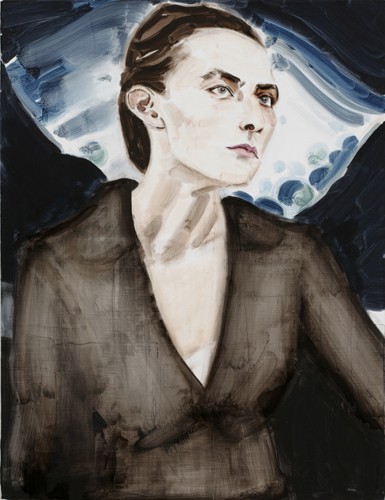
Georgia O ‘Keeffe after Stieglitz 1918, 2006 oil on canvas 76.5 × 58.7 cm Collection David Teiger Trust
© Elizabeth Peyton; courtesy Sadie Coles HQ, London; Gladstone Gallery, New York and Brussels; neugerriemschneider, Berlin
Throughout her corpus, Peyton’s color palette and graphic sensitivity transform her subjects, imbuing their likenesses with passion, magic and a sense of beauty that transcends the everyday. An acute understanding of the painterly mark, combined with a modest use of scale and bold stylistic shifts, often evokes a tension between outward appearance and interior subjectivity. In her drawings and monotypes, economical yet decisive marks imply both corporeality and contemplation.
In Peyton’s still life paintings and drawings, the themes and concerns which recur through her wider practice find concentrated form. Literature, selfhood, art history and the intertwinement of past and present – all are condensed within tightly-focused depictions of flowers, books and other objects. Often, the genre of portraiture infiltrates these works in the form of an obliquely-viewed book jacket or photograph. Pati and Flowers (2007), the first of Peyton’s still life works, combines a portrait (an image glimpsed on a postcard) with a flower study. Out of these juxtaposed idioms comes a sense of the underlying ‘abstraction’ of Peyton’s work – the repeated layering of intuitive marks – recalling Rainer Maria Rilke’s description of painting as “something that takes place among the colors.”
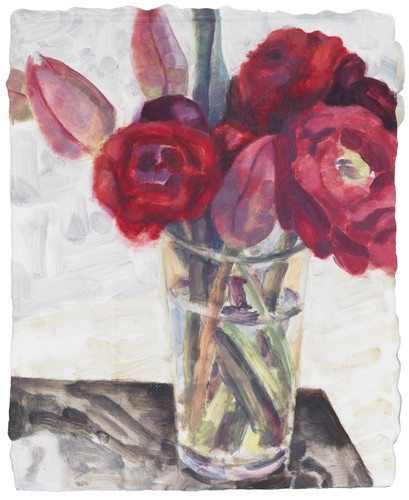
Flowers, Berlin, 2010 oil on board 25.4 × 20.3 cm Collection of Harm Müller-Spreer
© Elizabeth Peyton; courtesy Sadie Coles HQ, London; Gladstone Gallery, New York and Brussels; neugerriemschneider, Berlin
Just as the still life works act as repositories for objects and ideas, Peyton’s references to art history and the opera emphasize the interconnections between her sources of inspiration. As the critic Kirsty Bell has observed, “In Peyton’s works made ‘after’ existing works by other artists, various themes are brought in as a kind of ready-made content, depicted at one remove.” Flaubert in Egypt (After Delacroix) (2009-10) is based on a fragment of Delacroix’s Women of Algiers (1834). For Peyton, the act of translating Delacroix was also a means of evoking a parallel and contemporaneous inspiration – Flaubert’s memoir of his voyage to Egypt in 1849: “The image from Delacroix’s painting became a place to put all my feeling about Flaubert in Egypt,” the artist has explained. Over the past five years, Wagnerian opera –both its mythic narratives and spectacular stagings – has become a recurrent subject of Peyton’s work. Visually and thematically, it is an apt metaphor for her wider practice – a compendium of history, myth, memory and subjectivity.
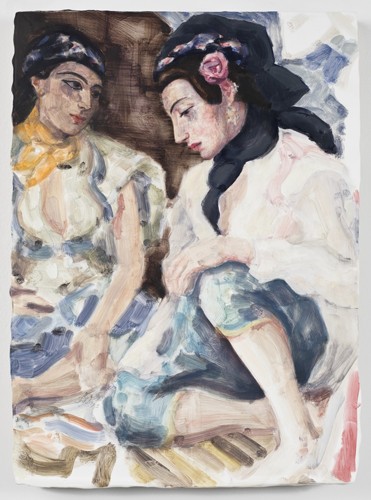
Flaubert in Egypt (After Delacroix), 2009 – 2010 oil on board 31.1 × 22.9cm Collection of Harm Müller-Spreer
© Elizabeth Peyton; courtesy Sadie Coles HQ, London; Gladstone Gallery, New York and Brussels; neugerriemschneider, Berlin
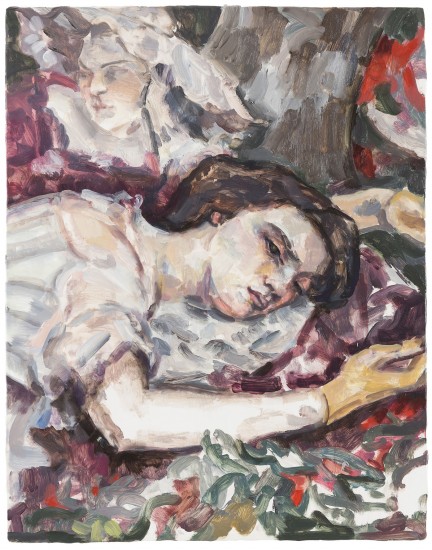
Two women (after Courbet), 2016 oil on panel 36.5 × 28.6cm Private Collection
© Elizabeth Peyton; courtesy Sadie Coles HQ, London; Gladstone Gallery, New York and Brussels; neugerriemschneider, Berlin
Artist Profile
Elizabeth Peyton studied at The School of Visual Arts, New York (graduating in 1987). Her major solo exhibitions include Here She Comes Now, Staatliche Kunsthalle Baden-Baden, Germany (2013); Ghost, a retrospective of the artist’s prints at the Mildred Lane Kemper Art Museum, St. Louis, USA, and Stiftung Opelvillen, Rüsselsheim, Germany (both 2011), and the major retrospective Live Forever at the Walker Art Center, Minneapolis, USA, touring to the New Museum, New York, Whitechapel Art Gallery, London, and Bonnefanten Museum, Maastricht, Holland (2009-10). Reading and Writing at the Irish Museum of Modern Art, Dublin, in 2009, brought together many literary-infused works. In Japan, she held a solo exhibition at Gallery Side 2, Tokyo in 1997 and was included in the Essential Painting exhibition at the National Museum of Art, Osaka, in 2006. Peyton lives and works in New York. An upcoming solo exhibition will be presented at the Académie de France in Rome – Villa Medici in 2017.
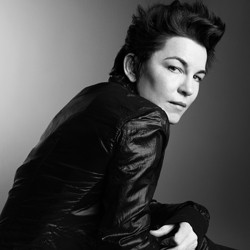
photo by Vinoodh Matadin and Inez van Lamsweerde
Exhibition Details
Title: Elizabeth Peyton: Still life
Dates: January 21 (Saturday) – May 7 (Sunday), 2017
Venue: Hara Museum of Contemporary Art
4-7-25 Kitashinagawa, Shinagawa-ku, Tokyo 140-0001 Tel: 03-3445-0651
E-mail: info@haramuseum.or.jp Website: http://www.haramuseum.or.jp
Mobile site: http://mobile.haramuseum.or.jp Blog: https://www.art-it.asia/en/u/HaraMuseum_e
Twitter: http://twitter.com/haramuseum (in Japanese only / account name: @haramuseum)
Organized by: Hara Museum of Contemporary Art, Hara Museum Fund
Cooperation provided by: Yoshiko Isshiki
Special cooperation provided by: Sadie Coles HQ, London; Gladstone Gallery, New York and Brussels; neugerriemschneider, Berlin
Hours: 11:00 am – 5:00 pm, Wednesdays until 8:00 pm (5:00 pm if a national holiday)(last entry 30 minutes before closing)
Closed: Mondays (except March 20), March 21
Admission: General 1,100 yen; Students 700 yen (high school and university) or 500 yen (elementary and junior high); Free for Hara Museum members, students through high school every Saturday during the school term; 100 yen discount per person for groups of 20 or more
Directions to the museum: 5 minutes by taxi or 15 minutes on foot from JR Shinagawa Station (Takanawa exit); or from the same station take the No.96 bus, get off at the first stop (Gotenyama), and walk 3 minutes
Guided tours: Free Japanese-language tours are given by a museum curator every Sunday and national holiday, starting at 2:30 pm and lasting about 30 minutes. No reservation is required. Free mini-tours in English are also available on a periodic basis. Please enquire at the admission counter on the day of your visit.
